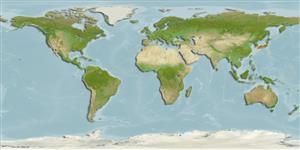Not assigned |
Sipuncula |
Golfingiidae
Environment: milieu / climate zone / depth range / distribution range
Ecology
Benthic. Temperate
Pacific Ocean: Japan, Sea of Okhotsk, the Sea of Japan, Gulf of California (Ref. 1815).
Length at first maturity / Size / Weight / Age
Maturity: Lm ? range ? - ? cm Max length : 2.5 cm TRKL male/unsexed; (Ref. 1840)
Large animals, from brownish-yellow to dark brown in color. Body 0.1 - 0.6 cm long, spindle shaped spindle shaped or cylindrical. Introvert somewhat longer than trunk. Surface of trunk smooth-seeming, as papillae covering it very small. Cephalon bearing dendritic crown of tentacles consisting of four main dichotomic branching trunks. Branches of tentacles pigmented with pinnules with violet grains. Smooth collar behind tentacles, with violet pigmentation. Zone of irregularly distributed large scalids behind cephalon. Longitudinal musculature of body wall not divided into longitudinal bands. Two retractors of introvert, both ventral, fastened to body wall in posterior third of body. Contractile
vessel with long, filiform, spirally twisted branches braiding internal organs. Intestine long, number of intestinal loops 16-20. Three fixing muscles, located individually for every animal. Anal opening level with nephridiopores. Wing muscles well-developed. No rectal
diverticulus found. Two nephridia fastened to body wall via mesenterial filaments along 1/4 of their length. Nephrida 80 percent as long as trunk (Ref. 1815).
Intertidal (Ref. 1815, 19 and 1840) to subtidal (Ref. 1815). Intertidal (Ref. 1815; 19 and 1840, page 149); subtidal species (Ref. 1815).
Life cycle and mating behavior
Maturity | Reproduction | Spawning | Eggs | Fecundity | Larvae
Morozov, T.B. and A.V. Adrianov 2002 Fauna of Sipunculans (Sipuncula) of Vostok Bay, Sea of Japan. Russian Journal of Marine Biology 28(6):365-370. (Ref. 1815)
IUCN Red List Status
(Ref. 130435: Version 2025-1)
CITES status (Ref. 108899)
Not Evaluated
Not Evaluated
Threat to humans
Human uses
| FishSource |
Tools
More information
Trophic EcologyFood items (preys)
Diet composition
Food consumption
Predators
Population dynamicsGrowth
Max. ages / sizes
Length-weight rel.
Length-length rel.
Length-frequencies
Mass conversion
Abundance
Life cycleReproduction
Maturity
Fecundity
Spawning
Eggs
Egg development
Larvae
PhysiologyOxygen consumption
Human RelatedStamps, coins, misc.
Internet sources
Estimates based on models
Fishing Vulnerability
Low vulnerability (10 of 100).
Price category
Unknown.
